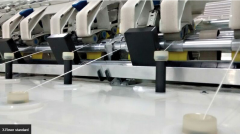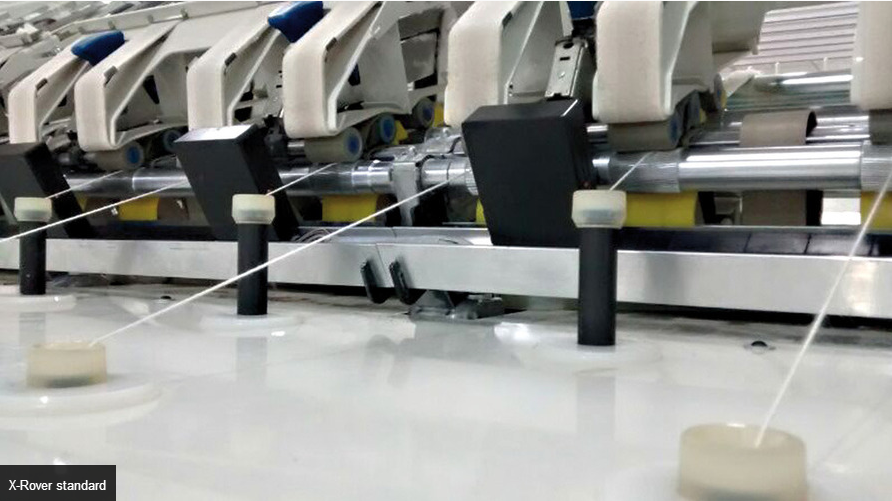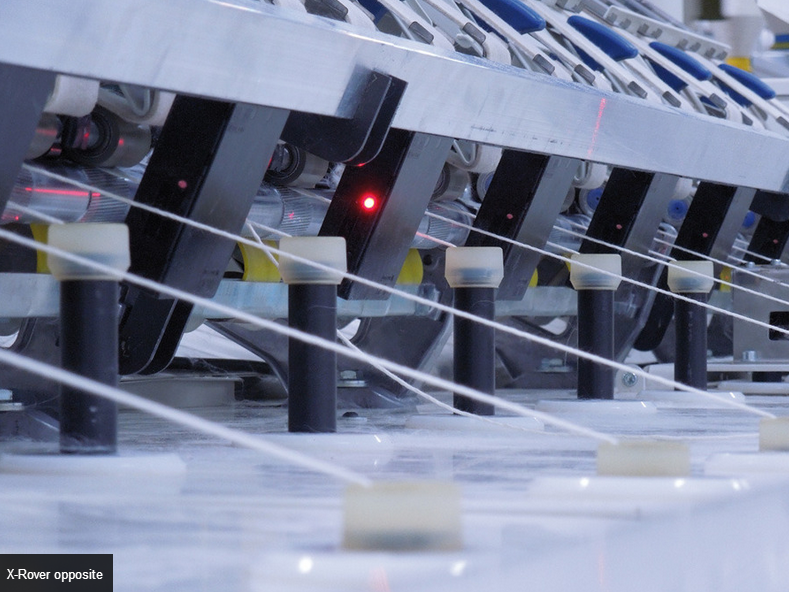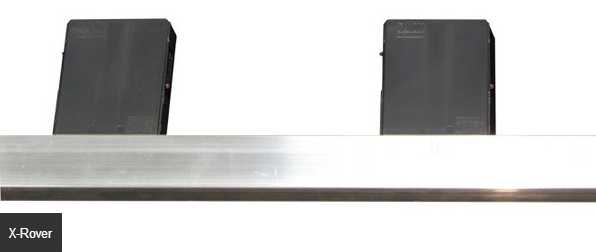-
X-Rover is an opto-electronic detector developed to check each individual position in Roving frames.
-
When the sensor detects the breakage of the roving, it sends a command to the roving frame to stop it.
-
The status of the filament is continuously monitored; abnormal status (broken / disabled sensor) are signalled by bright red L.E.D. in the corresponding roving position.
-
From the control unit included it’s possible to see the position where occurred the bigger number of breaks, so, it’s easy to detect the worst position in the machine.
Special Features
-
No parts in movement: Less maintenance.
-
Optical sensor: a hi-tech sensor that feels the status of the roving without to touch it.
-
By the control unit (always included) it’s possible to set the parameters, in order to work with -any count and colour of roving.
-
Linkable with other Pinterfani products and options. (Eureka; LED display; Energy Save)
-
Two disabling options: automatic and manual.
-
Available for any roving frame machine.
-
One bright L.E.D. for each spinning position.
Advantages
-
Easy detection of the broken roving: the red L.E.D is visible from long distance, so, operator could run directly in the position where his work is request.
-
Easy to detect the worst position for number of breaks, that cause the longest stoppages.
-
Increase of production, just finding the position where the breaks are more frequently and fixing the problem.
-
We only use high quality aluminium for our sensors. Rust never appear.
-
The best way to get high efficiency in modern roving frames, with many positions.
-
According to machine model, it could be installed with the aluminium profile below or over the rovings.
Versions
-
XRST: X-Rover Standard:
Standard: The aluminium profile is installed below the rovings.
-
XROP:X-Rover Opposite:
Opposite: The aluminium profile is installed over the rovings.
Thanks the system, operator can control more ring frames staying outside the machines. Then he go first in the alley where more yarns are broken, avoiding the alley without breaks and reducing the piecing time.
yle="box-sizing: border-box; margin: 10px 0px 0px; list-style-type: none; padding-right: 0px; padding-left: 0px; color: rgb(46 63 73); font-family: latoregular; font-size: 17px; line-height: 26px; border-top-left-radius: 0px !important; border-top-right-radius: 0px !important; border-bottom-right-radius: 0px !important; border-bottom-left-radius: 0px !important;">
-
yle="box-sizing: border-box; border-top-left-radius: 0px !important; border-top-right-radius: 0px !important; border-bottom-right-radius: 0px !important; border-bottom-left-radius: 0px !important; background-image: url(http://www.fani.com/img/star.png); background-attachment: scroll; background-color: transparent; padding: 4px 0px 0px 35px; list-style-type: none; background-position: 10px 8px; background-repeat: no-repeat no-repeat;"> X-Rover is an opto-electronic detector developed to check each individual position in Roving frames.
-
yle="box-sizing: border-box; border-top-left-radius: 0px !important; border-top-right-radius: 0px !important; border-bottom-right-radius: 0px !important; border-bottom-left-radius: 0px !important; background-image: url(http://www.fani.com/img/star.png); background-attachment: scroll; background-color: transparent; padding: 4px 0px 0px 35px; list-style-type: none; background-position: 10px 8px; background-repeat: no-repeat no-repeat;"> When the sensor detects the breakage of the roving it sends a command to the roving frame to stop it.
-
yle="box-sizing: border-box; border-top-left-radius: 0px !important; border-top-right-radius: 0px !important; border-bottom-right-radius: 0px !important; border-bottom-left-radius: 0px !important; background-image: url(http://www.fani.com/img/star.png); background-attachment: scroll; background-color: transparent; padding: 4px 0px 0px 35px; list-style-type: none; background-position: 10px 8px; background-repeat: no-repeat no-repeat;"> The status of the filament is continuously monitored; abnormal status (broken / disabled sensor) are signalled by bright red L.E.D. in the corresponding roving position.
-
yle="box-sizing: border-box; border-top-left-radius: 0px !important; border-top-right-radius: 0px !important; border-bottom-right-radius: 0px !important; border-bottom-left-radius: 0px !important; background-image: url(http://www.fani.com/img/star.png); background-attachment: scroll; background-color: transparent; padding: 4px 0px 0px 35px; list-style-type: none; background-position: 10px 8px; background-repeat: no-repeat no-repeat;"> From the control unit included it’s possible to see the position where occurred the bigger number of breaks so it’s easy to detect the worst position in the machine.。
yle="box-sizing: border-box; margin: 0px 0px 20px; font-size: 17px; line-height: 26px; font-family: latoregular; color: rgb(46 63 73); border-top-left-radius: 0px !important; border-top-right-radius: 0px !important; border-bottom-right-radius: 0px !important; border-bottom-left-radius: 0px !important;">
yle="box-sizing: border-box; border-top-left-radius: 0px !important; border-top-right-radius: 0px !important; border-bottom-right-radius: 0px !important; border-bottom-left-radius: 0px !important;" /> yle="box-sizing: border-box; border-top-left-radius: 0px !important; border-top-right-radius: 0px !important; border-bottom-right-radius: 0px !important; border-bottom-left-radius: 0px !important;">Special Features
yle="box-sizing: border-box; margin: 10px 0px 0px; list-style-type: none; padding-right: 0px; padding-left: 0px; color: rgb(46 63 73); font-family: latoregular; font-size: 17px; line-height: 26px; border-top-left-radius: 0px !important; border-top-right-radius: 0px !important; border-bottom-right-radius: 0px !important; border-bottom-left-radius: 0px !important;">
-
yle="box-sizing: border-box; border-top-left-radius: 0px !important; border-top-right-radius: 0px !important; border-bottom-right-radius: 0px !important; border-bottom-left-radius: 0px !important; background-image: url(http://www.fani.com/img/star.png); background-attachment: scroll; background-color: transparent; padding: 4px 0px 0px 35px; list-style-type: none; background-position: 10px 8px; background-repeat: no-repeat no-repeat;"> No parts in movement: Less maintenance.
-
yle="box-sizing: border-box; border-top-left-radius: 0px !important; border-top-right-radius: 0px !important; border-bottom-right-radius: 0px !important; border-bottom-left-radius: 0px !important; background-image: url(http://www.fani.com/img/star.png); background-attachment: scroll; background-color: transparent; padding: 4px 0px 0px 35px; list-style-type: none; background-position: 10px 8px; background-repeat: no-repeat no-repeat;"> Optical sensor: a hi-tech sensor that feels the status of the roving without to touch it.
-
yle="box-sizing: border-box; border-top-left-radius: 0px !important; border-top-right-radius: 0px !important; border-bottom-right-radius: 0px !important; border-bottom-left-radius: 0px !important; background-image: url(http://www.fani.com/img/star.png); background-attachment: scroll; background-color: transparent; padding: 4px 0px 0px 35px; list-style-type: none; background-position: 10px 8px; background-repeat: no-repeat no-repeat;"> By the control unit (always included) it’s possible to set the parameters in order to work with -any count and colour of roving.
-
yle="box-sizing: border-box; border-top-left-radius: 0px !important; border-top-right-radius: 0px !important; border-bottom-right-radius: 0px !important; border-bottom-left-radius: 0px !important; background-image: url(http://www.fani.com/img/star.png); background-attachment: scroll; background-color: transparent; padding: 4px 0px 0px 35px; list-style-type: none; background-position: 10px 8px; background-repeat: no-repeat no-repeat;"> linkable with other Pinterfani products and options. (Eureka; LED display; Energy Save)
-
yle="box-sizing: border-box; border-top-left-radius: 0px !important; border-top-right-radius: 0px !important; border-bottom-right-radius: 0px !important; border-bottom-left-radius: 0px !important; background-image: url(http://www.fani.com/img/star.png); background-attachment: scroll; background-color: transparent; padding: 4px 0px 0px 35px; list-style-type: none; background-position: 10px 8px; background-repeat: no-repeat no-repeat;"> Two disabling options: automatic and manual.
-
yle="box-sizing: border-box; border-top-left-radius: 0px !important; border-top-right-radius: 0px !important; border-bottom-right-radius: 0px !important; border-bottom-left-radius: 0px !important; background-image: url(http://www.fani.com/img/star.png); background-attachment: scroll; background-color: transparent; padding: 4px 0px 0px 35px; list-style-type: none; background-position: 10px 8px; background-repeat: no-repeat no-repeat;"> Available for any roving frame machine.
-
yle="box-sizing: border-box; border-top-left-radius: 0px !important; border-top-right-radius: 0px !important; border-bottom-right-radius: 0px !important; border-bottom-left-radius: 0px !important; background-image: url(http://www.fani.com/img/star.png); background-attachment: scroll; background-color: transparent; padding: 4px 0px 0px 35px; list-style-type: none; background-position: 10px 8px; background-repeat: no-repeat no-repeat;"> One bright L.E.D. for each spinning position.
yle="box-sizing: border-box; margin: 0px 0px 20px; font-size: 17px; line-height: 26px; font-family: latoregular; color: rgb(46 63 73); border-top-left-radius: 0px !important; border-top-right-radius: 0px !important; border-bottom-right-radius: 0px !important; border-bottom-left-radius: 0px !important;">
yle="box-sizing: border-box; border-top-left-radius: 0px !important; border-top-right-radius: 0px !important; border-bottom-right-radius: 0px !important; border-bottom-left-radius: 0px !important;" /> yle="box-sizing: border-box; border-top-left-radius: 0px !important; border-top-right-radius: 0px !important; border-bottom-right-radius: 0px !important; border-bottom-left-radius: 0px !important;">Advantages
yle="box-sizing: border-box; margin: 10px 0px 0px; list-style-type: none; padding-right: 0px; padding-left: 0px; color: rgb(46 63 73); font-family: latoregular; font-size: 17px; line-height: 26px; border-top-left-radius: 0px !important; border-top-right-radius: 0px !important; border-bottom-right-radius: 0px !important; border-bottom-left-radius: 0px !important;">
-
yle="box-sizing: border-box; border-top-left-radius: 0px !important; border-top-right-radius: 0px !important; border-bottom-right-radius: 0px !important; border-bottom-left-radius: 0px !important; background-image: url(http://www.fani.com/img/star.png); background-attachment: scroll; background-color: transparent; padding: 4px 0px 0px 35px; list-style-type: none; background-position: 10px 8px; background-repeat: no-repeat no-repeat;"> Easy detection of the broken roving: the red L.E.D is visible from long distance so operator could run directly in the position where his work is request.
-
yle="box-sizing: border-box; border-top-left-radius: 0px !important; border-top-right-radius: 0px !important; border-bottom-right-radius: 0px !important; border-bottom-left-radius: 0px !important; background-image: url(http://www.fani.com/img/star.png); background-attachment: scroll; background-color: transparent; padding: 4px 0px 0px 35px; list-style-type: none; background-position: 10px 8px; background-repeat: no-repeat no-repeat;"> Easy to detect the worst position for number of breaks that cause the longest stoppages.
-
yle="box-sizing: border-box; border-top-left-radius: 0px !important; border-top-right-radius: 0px !important; border-bottom-right-radius: 0px !important; border-bottom-left-radius: 0px !important; background-image: url(http://www.fani.com/img/star.png); background-attachment: scroll; background-color: transparent; padding: 4px 0px 0px 35px; list-style-type: none; background-position: 10px 8px; background-repeat: no-repeat no-repeat;"> Increase of production just finding the position where the breaks are more frequently and fixing the problem.
-
yle="box-sizing: border-box; border-top-left-radius: 0px !important; border-top-right-radius: 0px !important; border-bottom-right-radius: 0px !important; border-bottom-left-radius: 0px !important; background-image: url(http://www.fani.com/img/star.png); background-attachment: scroll; background-color: transparent; padding: 4px 0px 0px 35px; list-style-type: none; background-position: 10px 8px; background-repeat: no-repeat no-repeat;"> We only use high quality aluminium for our sensors. Rust never appear.
-
yle="box-sizing: border-box; border-top-left-radius: 0px !important; border-top-right-radius: 0px !important; border-bottom-right-radius: 0px !important; border-bottom-left-radius: 0px !important; background-image: url(http://www.fani.com/img/star.png); background-attachment: scroll; background-color: transparent; padding: 4px 0px 0px 35px; list-style-type: none; background-position: 10px 8px; background-repeat: no-repeat no-repeat;"> The best way to get high efficiency in modern roving frames with many positions.
-
yle="box-sizing: border-box; border-top-left-radius: 0px !important; border-top-right-radius: 0px !important; border-bottom-right-radius: 0px !important; border-bottom-left-radius: 0px !important; background-image: url(http://www.fani.com/img/star.png); background-attachment: scroll; background-color: transparent; padding: 4px 0px 0px 35px; list-style-type: none; background-position: 10px 8px; background-repeat: no-repeat no-repeat;"> According to machine model it could be installed with the aluminium profile below or over the rovings.
yle="box-sizing: border-box; margin: 0px 0px 20px; font-size: 17px; line-height: 26px; font-family: latoregular; color: rgb(46 63 73); border-top-left-radius: 0px !important; border-top-right-radius: 0px !important; border-bottom-right-radius: 0px !important; border-bottom-left-radius: 0px !important;">
yle="box-sizing: border-box; border-top-left-radius: 0px !important; border-top-right-radius: 0px !important; border-bottom-right-radius: 0px !important; border-bottom-left-radius: 0px !important;" /> yle="box-sizing: border-box; border-top-left-radius: 0px !important; border-top-right-radius: 0px !important; border-bottom-right-radius: 0px !important; border-bottom-left-radius: 0px !important;">Versions
yle="box-sizing: border-box; margin: 10px 0px 0px; list-style-type: none; padding-right: 0px; padding-left: 0px; color: rgb(46 63 73); font-family: latoregular; font-size: 17px; line-height: 26px; border-top-left-radius: 0px !important; border-top-right-radius: 0px !important; border-bottom-right-radius: 0px !important; border-bottom-left-radius: 0px !important;">
-
yle="box-sizing: border-box; border-top-left-radius: 0px !important; border-top-right-radius: 0px !important; border-bottom-right-radius: 0px !important; border-bottom-left-radius: 0px !important; background-image: url(http://www.fani.com/img/star.png); background-attachment: scroll; background-color: transparent; padding: 4px 0px 0px 35px; list-style-type: none; background-position: 10px 8px; background-repeat: no-repeat no-repeat;"> yle="box-sizing: border-box; border-top-left-radius: 0px !important; border-top-right-radius: 0px !important; border-bottom-right-radius: 0px !important; border-bottom-left-radius: 0px !important;">yle="box-sizing: border-box; border-top-left-radius: 0px !important; border-top-right-radius: 0px !important; border-bottom-right-radius: 0px !important; border-bottom-left-radius: 0px !important;">XRST: X-Rover Standard:
yle="box-sizing: border-box; border-top-left-radius: 0px !important; border-top-right-radius: 0px !important; border-bottom-right-radius: 0px !important; border-bottom-left-radius: 0px !important;" /> yle="box-sizing: border-box; border-top-left-radius: 0px !important; border-top-right-radius: 0px !important; border-bottom-right-radius: 0px !important; border-bottom-left-radius: 0px !important;">yle="box-sizing: border-box; border-top-left-radius: 0px !important; border-top-right-radius: 0px !important; border-bottom-right-radius: 0px !important; border-bottom-left-radius: 0px !important;">Standard: The aluminium profile is installed below the rovings.
-
yle="box-sizing: border-box; border-top-left-radius: 0px !important; border-top-right-radius: 0px !important; border-bottom-right-radius: 0px !important; border-bottom-left-radius: 0px !important; background-image: url(http://www.fani.com/img/star.png); background-attachment: scroll; background-color: transparent; padding: 4px 0px 0px 35px; list-style-type: none; background-position: 10px 8px; background-repeat: no-repeat no-repeat;"> yle="box-sizing: border-box; border-top-left-radius: 0px !important; border-top-right-radius: 0px !important; border-bottom-right-radius: 0px !important; border-bottom-left-radius: 0px !important;">yle="box-sizing: border-box; border-top-left-radius: 0px !important; border-top-right-radius: 0px !important; border-bottom-right-radius: 0px !important; border-bottom-left-radius: 0px !important;">XROP:X-Rover Opposite:
yle="box-sizing: border-box; border-top-left-radius: 0px !important; border-top-right-radius: 0px !important; border-bottom-right-radius: 0px !important; border-bottom-left-radius: 0px !important;" /> yle="box-sizing: border-box; border-top-left-radius: 0px !important; border-top-right-radius: 0px !important; border-bottom-right-radius: 0px !important; border-bottom-left-radius: 0px !important;">yle="box-sizing: border-box; border-top-left-radius: 0px !important; border-top-right-radius: 0px !important; border-bottom-right-radius: 0px !important; border-bottom-left-radius: 0px !important;">Opposite: The aluminium profile is installed over the rovings.
yle="box-sizing: border-box; margin: 0px 0px 20px; font-size: 17px; line-height: 26px; font-family: latoregular; color: rgb(46 63 73); border-top-left-radius: 0px !important; border-top-right-radius: 0px !important; border-bottom-right-radius: 0px !important; border-bottom-left-radius: 0px !important;">
yle="box-sizing: border-box; border-top-left-radius: 0px !important; border-top-right-radius: 0px !important; border-bottom-right-radius: 0px !important; border-bottom-left-radius: 0px !important;" /> Thanks the system operator can control more ring frames staying outside the machines. Then he go first in the alley where more yarns are broken avoiding the alley without breaks and reducing the piecing time.

 English
English 简体中文
简体中文





